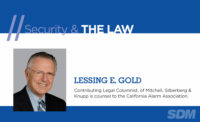Negligence Action: The Firefighter's Rule

A recent case in the state of Rhode Island dealt with the issue of when “the firefighter’s rule” applies. The plaintiff was a firefighter who filed a negligence action against a hospital and a security company. They, in turn, filed a motion for summary judgment claiming that the suit was barred by the firefighter’s rule. The Superior Court agreed with the defendants and granted the defendants’ motion for summary judgment. The firefighter appealed.
The facts of the case indicated that the firefighter delivered the patient to the defendant hospital and subsequently that he assisted a nurse and security guards in attempting to subdue an unruly patient. The patient injured him so badly that he could no longer perform his job duties. The firefighter alleged that defendants were negligent when they failed to restrain the patient and that failure caused the injuries.
Rhode Island law provides that whenever any police officer, firefighter, rescue person, among others, is injured performing his or her duties within the state of Rhode Island at any occurrence involving the protection or rescue of human life that necessitates that they respond in a professional capacity when they would normally be considered to be off duty, during the period of incapacity to work, pay to that police officer, firefighter, et al the salary or wage and benefits to which they would be entitled had he or she not been injured should be given.
In order to receive the benefits provided above, the police officer or firefighter, et al, must prove to their employer that he or she had reasonable grounds to believe that there was an emergency that required an immediate need for their assistance for the protection or rescue of human life.
In analyzing the case, the court needed to determine if the firefighter’s rule rule, applied.
To be shielded from liability under the firefighter’s rule, the defendants needed to establish (1) that the defendants injured the police officer or firefighter in the course of his or her employment, (2) that the risk the defendants created was the type of risk that one could reasonably anticipate would arise in the dangerous situation that their employment requires them to encounter, and (3) that the defendants created the dangerous situation that brought the police officer or firefighter to the crime scene, accident scene or fire.
The court indicated that what was required was that there be some “connection” between the defendants and the emergency that brought the firefighter to the place where he or she was injured. The first part of the firefighter’s rule was satisfied because there was no question that the plaintiff was injured during the course of his employment duties as a firefighter . The firefighter actually received injured-on-duty pay pursuant to the statute. The requirements of the second part were also met because the firefighter reasonably anticipated the risks that were posed by an encounter with an unruly patient; that was a risk he had encountered on several occasions in the past.
The key to the case was the third part of the firefighter’s rule: Did the defendants cause the firefighter to go to the place where he was injured? The court indicated that they believed that they had. The firefighter’s injury was detached from the original emergency. When he completed his original task of transporting the first patient to the hospital, he left the emergency scene involving the first patient and moved to a new emergency scene after a nurse at the hospital requested his assistance with a difficult patient. At that point, the first emergency ended and a new emergency, allegedly created by the negligent restraint of the patient, began.
The court also pointed out two preeminent theories that serve as foundations for the firefighter’s rule. The first is primary assumption of the risk; the firefighters and public safety officers are deemed as a matter of law, to assume all normal risks when they accept the position. Secondly, it is inappropriate for these officials to recover for negligent acts that may result in emergencies that create the very need for their employment in the first place.
Therefore, the court held that the firefighter’s rule barred the firefighter’s claim against the defendants, and the opinion of the lower court granting the motion for summary judgment was upheld.
Lessing E. Gold of Mitchell, Silberberg & Knupp is counsel to the California Alarm Association.
Question: My subscriber just had a loss. The system did not activate. Our inspection indicates that the subscriber tampered with the system, which he denies. Do I have any exposure?
Answer: First, I assume that under the terms of your contract with the subscriber, the subscriber agreed that he would not tamper with the system. If you had reason to believe the subscriber tampered with the system then, of course, it should have been inspected and repaired. If you had no knowledge or had no reason to believe that the system was tampered with, then you have no duty to do anything about it. Notwithstanding, if your contract was properly drafted and included the normal protective provisions, your exposure would be limited.
Looking for a reprint of this article?
From high-res PDFs to custom plaques, order your copy today!






